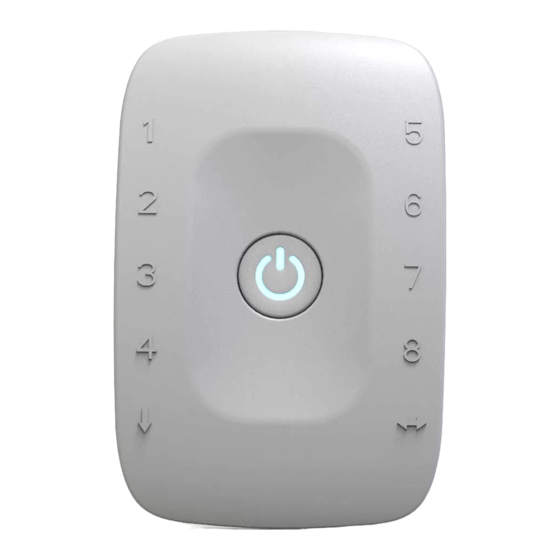
Subscribe to Our Youtube Channel
Summary of Contents for Plux biosignalsplux Light
- Page 1 biosignal acquisition tool-kit for advanced research applications Light (LUX) Sensor User Manual...
- Page 2 The information contained in this document has been carefully checked and were made every effort to ensure its quality. PLUX reserves the right to make changes and improvements to this manual and products referenced at any time without notice.
-
Page 3: Table Of Contents
Light (LUX) User Manual TABLE OF CONTENTS General Information ......................4 1.1. General Description ......................4 1.2. Typical Unfiltered Sensor Output..................4 1.3. Sensor Specifications ......................5 1.4. Features ..........................5 1.5. Applications........................5 1.6. Transfer Function (Conversion Formula) ................5 1.7. -
Page 4: General Information
(e.g. heart rate) in dependence of the ambient light changes or visual evoked potentials. Figure 1: biosignalsplux Light (LUX) sensor (standard version). 1.2. Typical Unfiltered Sensor Output Figure 2 shows a typical unfiltered sensor output acquired while light changes. -
Page 5: Sensor Specifications
Light (LUX) User Manual 1.3. Sensor Specifications > Range: 400-700 nm > Consumption: ~0.05 mA [550 nm | peak spectral wavelength] 1.4. Features > Pre-conditioned analog output > Small form factor > High signal-to-noise ratio > Easy-to-use > Raw data output 1.5. -
Page 6: Physical Characteristics
White, Black, Blue, Green, Red, Yellow, Grey, and Brown Sensor also available with A dimension equal to 30cm cable length. For custom lengths, please contact our operations team via orders@plux.info. Figure 3: Physical characteristics of the standard Light (LUX) sensor. -
Page 7: Application Notes
The illustration shown in Figure 4 shows a possible sensor placement for the acquisition of ambient light detection (screen of laptop). Figure 4: biosignalsplux light (LUX) sensor applied to computer screen After placing the sensor in the desired location, connect the device with the... -
Page 8: Using The Light (Lux) Sensor With Biosignalsplux & Opensignals
Light (LUX) User Manual 3. Using the Light (LUX) Sensor with biosignalsplux & OpenSignals 3.1. Connecting the sensor to biosignalsplux Systems 3.1.1. biosignalsplux 4-Channel Hubs biosignalsplux LUX sensor is compatible with all 4 analog input channels of the 4-channel biosignalsplux hub, but incompatible with the reference/ground port. -
Page 9: Biosignalsplux Solo & Single-Channel Openban Devices
Light (LUX) User Manual 3.1.3. biosignalsplux Solo & Single-Channel openBAN Devices biosignalsplux LUX sensor is compatible with the analog input channel of the biosignalsplux Solo (openBAN) device. Connect the sensor to the analog input channel to use it with this device. Figure 7: Connect the LUX to the analog input channel of the biosignalsplux Solo (openBAN). - Page 10 Light (LUX) User Manual Select the device you intend to use for acquisition by clicking on ENABLE button on the device panel in the OpenSignals device manager. The device is activated for acquisition if the ENABLE button is blue. Figure 9: Enabling the device for acquisition. Click on the biosignalsplux logo to access the available settings.
- Page 11 Light (LUX) User Manual Figure 11: Start the acquisition whenever you’re ready. 11 of 17...
-
Page 12: Scientific Publications Using The Light (Lux) Sensor
Light (LUX) User Manual 4. Scientific Publications Using the Light (LUX) Sensor The following scientific is only a small selection extracted from the list of available publications using biosignalsplux. Please visit the following website to access the entire up-to-date list: biosignalsplux Publications List of Publications Publications... -
Page 13: Safety & Maintenance
The user should use the sensor cables with extreme caution to avoid risk of strangulation. The user should keep a safe distance between the biosignalsplux device and other devices to ensure their proper functioning. The user should only send the device to repair to qualified PLUX personnel. 13 of 17... -
Page 14: Transportation And Storage
Light (LUX) User Manual The user should not immerse the sensors or the biosignalsplux device, nor clean with liquid or abrasives. The user should handle the biosignalsplux device with caution and not expose the device or accessories to high accelerations and vibrations. biosignalsplux devices should not be used in patients with implanted electronic devices of any kind, including pace-makers, electronic infusion pumps, stimulators, defibrillators or similar. -
Page 15: Ordering Guides, Regulatory & Legal Information
If PLUX receives notification of any such defects within the guarantee period, it will repair or substitute with the same unit/model, any products with proven defects at no cost to the client. During the repair period PLUX promises to provide a temporary replacement under the same specification. -
Page 16: Contact & Support
Please send us an e-mail with precise information about the error occurrence, device configuration, and, if possible, screenshots of the problem to support@plux.info. 6.5. Regulatory Disclaimer biosignalsplux products are intended for use in life science education and research applications; they are not medical devices nor are they intended for medical diagnosis, cure, mitigation, treatment or prevention of disease. - Page 17 Light (LUX) User Manual PLUX Wireless Biosignals S.A. email: plux@plux.info web: http://www.plux.info Headquarters Zona Industrial das Corredouras, Lt. 14 – 1° 2630-369 Arruda dos Vinhos Portugal tel.: +351 263 978 572 fax: +351 263 978 902 Lisbon Office Av. 5 de Outubro, n° 70 – 2°...




Need help?
Do you have a question about the biosignalsplux Light and is the answer not in the manual?
Questions and answers